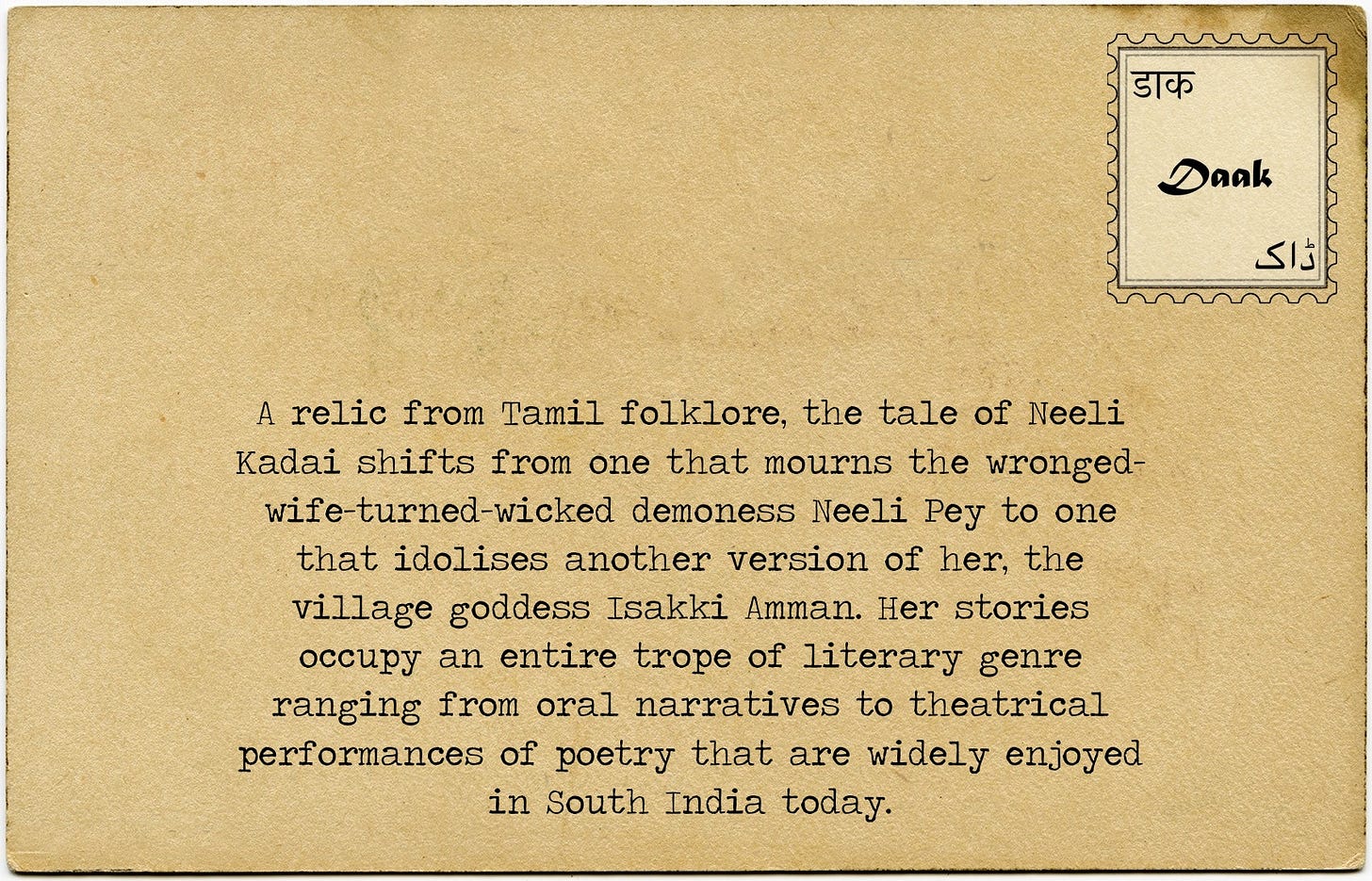The Divine and the Damned: The Tale of Neeli Kadai
The story of Neelakesi was first narrated by the saint Chekkizhar in the Tamil epic Periyapuranam, in the twelfth century AD. Neeli was the devoted, pregnant wife of a Brahmin of Pazhayanur. The Brahmin, however, fell for the charms of a prostitute and killed his expecting wife, robbing her of all her precious jewellery. He was later reincarnated as a merchant who wandered to Pazhanayur to explore his prospects for trade. Neeli, now a bloodthirsty ghost, chased after him with a sickly looking child (presumably the ghost of the one she had been expecting). Vehemently insisting that she was his wife, Neeli sobbed her heart out and begged the Vellalar (the agricultural community of wealthy landlords) to reinstate her conjugal rights. Neeli’s appeals had the intended effect: despite the Brahmin’s cries of protest that he did not know her, he was forced to live with her as her husband and the father of her child.
It is a testament to the immortality of folklore that even today, a woman’s tears of (apparent) deception are called neeli kannir, or false tears. The disregard for Neeli’s real trauma also offers insight into the assumption that women are inclined to exaggerated emotional displays of pain where none exists.
On the night of the judgement, Neeli avenged her and her unborn child’s murder by viciously murdering the Brahmin. Stricken with guilt, all seventy Vellala elders who had given the judgement committed mass suicide by immolating themselves. Legend has it that Neeli continued to strike fear in people’s hearts as the fearsome Kali of Tiruvalangadu. Her rage petrified even the gods, who turned to Lord Shiva for help. As depicted at many sacred Shaivite sites, Shiva challenged Kali to a dancing contest. Until he resorted to the Chanda stance, which involved lifting up the legs, she rivalled him step for step. Wanting to keep her modesty intact, however, she was forced to admit defeat. Even today, the dancing Nataraja at Tiruvalangadu stands tall while Kali is depicted as a smaller, subdued figure beside him.
Another significant representation of the Neeli tale is found in the widely prevalent genre of musical story narration in Tamil Nadu known as the Villupattu. Unlike the Buddhist and Hindu tales of Neeli as a modest wife, in Villupattu, she is depicted as a prostitute called Lakshmi who was murdered by a Brahmin. After avenging her death in her next birth, she goes on to become the dreaded dur devatai, or village goddess Issaki Amman. Her dying curse in these musical narrations goes thus:
I have hurt no one
Committed no injustice
Neither thought ill of any
Nor done a foul deed
But here I am all alone
In this desolate forest
None else my support
You know, my God!
This Kalli tree is my witness
The sun and the moon my witness
The drooping kalli will bear witness
That even a Brahmin can murder
Can Pazhayanallur survive this heinous crime!
(From Re-searching Indian Women, by Vijaya Ramaswamy)
Society and mythology often portray South Asian womanhood in strict binaries with a clear split between women’s seductive powers and maternal abilities. The legend of Neeli also sways between these two binaries — for some she is the wronged-wife-turned-wicked demoness Neeli Pey, and for others, the prostitute-turned-revered-goddess Isakki Amman. Given society’s discomfort with female sexuality, it is significant that she is worshipped by the non Brahmin communities of Tamil Nadu. It is also worth noting that indigenous stories are so often adapted and remoulded to fit into the dominant patriarchal social order.
From a virtuous wife to a vengeful temptress, the diversification of Neelakesi’s story occupies an entire trope of literary genre ranging from oral narratives to theatrical performances of poetry that are widely enjoyed in South India today.
You can read more about the other versions of the story of Neeli here.
By Fiza Mishra



